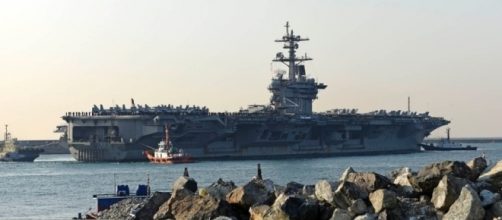As a candidate, Donald Trump has put emphasis on what he considers to be many threats to the United States with little hint that he saw North Korea as one of them. On the campaign trail, he said that he was impressed by leader Kim Jong-un because of how much power he was given at such a young age. But he also stated that he would like to sit and have a burger with him, and yet his response to North Korea as President has given no hint that he even wanted to reach out. Blasting News reported on the increase in tensions between the two countries which started when the administration canceled back channel talks with DPRK diplomats at the last minute, then when he reportedly sent a Naval Strike Group to the East China Sea.
On April 18, the Washington Post was one of the media outlets reporting that since the initial announcement made by various officials under the Trump administration on April 8, the Uss Carl Vinson and the strike force it leads were 3,000 miles away from North Korea, going in the opposite direction. Their article titled: "Despite talk of a military strike, Trump’s ‘armada’ actually sailed away from Korea" referred to various officials such as Adm. Harry Harris, followed by a Pacific Command spokesman, then Defense Secretary Jim Mattis and President Trump who said that the armada had been sent. The article states that the media jumped on this announcement and included this in the narrative about tensions building up between the U.S.
and Pyongyang.
Reporting on missing armada
As noted, Blasting News was one of the outlets to report on this announcement, and even while the DPRK held a military parade last Saturday; one could clearly imagine the strike force nearby waiting for Kim Jong-un to give the order for another ballistic missile test and/or the testing of an underground nuclear bomb. Pyongyang also believed this to be true as they said that they would retaliate against any signs of aggression from the American armada to go with reports that Japan had sent their destroyers to join the strike group. Even more, there were also reports recently that China and Russia had sent spy ships to go after the armada. But it was Defense News which reported on the actual whereabouts of the strike group, saying they were in the Indian Ocean for training exercises with Australia.
When Cmdr. Clayton Doss, a Pacific Fleet spokesman was asked about this on Monday, he said that the group was "transiting the Western Pacific," but would not provide any more details on its actual location ruling out that they were near Korea or Japan.
Regional response
As stated, North Korea threatened to retaliate after the news. It was also reported that Chinese President Xi Jinping had called President Trump days after their meeting at Mar-a-Lago and said publicly that the two countries should try to seek calm. President Trump's show of military force following the U.S. military attack on a Syrian air base with 59 Tomahawk missiles, were being used as leverage as confirmed by Vice-President Mike Pence when he referred to in a statement while in Japan this week.
The Washington Post article said that these signs of aggression by the United States weighed heavily on the Chinese government, with whom Trump has reportedly established good relations. But it also says that the Chinese are relieved that the warships are not in the area.
The Washington Post article included some insight by an expert from the Center for Korean Studies at Fudan University in Shanghai named Cai Jian, who said this was part of psychological warfare and bluffing, which he added was very important to pressuring the North. But a nonresident senior fellow at the Center for Strategic Budgetary Assessments named Ross Babbage said that he didn't think the administration was bluffing. He said that the U.S.
was likely giving China time to rein in North Korea. In another Blasting News article that talked about the U.S. military threat to leverage trade negotiations, it mentions how the U.S. needs China for anything to happen with North Korea. Thus far, the strike group is now said to be expected to arrive in South Korea at the end of April.

